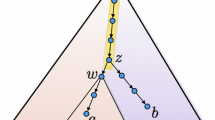Abstract.
This paper presents a self-stabilizing algorithm that finds the bridge-connected components of a connected undirected graph on an asynchronous distributed or network model of computation. An edge of a graph is a bridge if its removal disconnects the graph. The bridge-connected components problem consists of finding the maximal connected subgraphs (components) of the given graph such that none of the components contains a bridge. The output of the algorithm is available in a distributed manner in the sense that, upon termination of the algorithm, each node of the graph knows its component number: the component number is a representative node number which uniquely identifies a bridge-connected component. It has been proved that the alogrithm is correct and requires \(O(n^2)\) time if the depth-first search spanning tree of the graph is known, or else it requires \(O(n^2+n\cdot d\cdot\Delta)\) time, where n is the number of nodes, d is the graph diameter, and Δ is an upper bound on the degree of a node.
Similar content being viewed by others
Explore related subjects
Discover the latest articles and news from researchers in related subjects, suggested using machine learning.Author information
Authors and Affiliations
Additional information
Received: May 15, 1998
Rights and permissions
About this article
Cite this article
Chaudhuri, P. An \(O(n^2)\) Self-Stabilizing Algorithm for Computing Bridge-Connected Components. Computing 62, 55–67 (1999). https://doi.org/10.1007/s006070050013
Issue Date:
DOI: https://doi.org/10.1007/s006070050013




